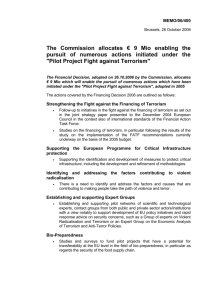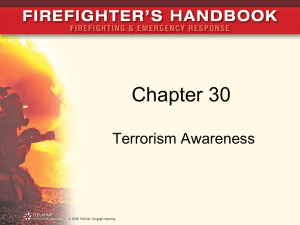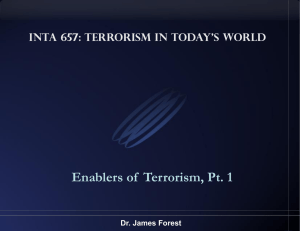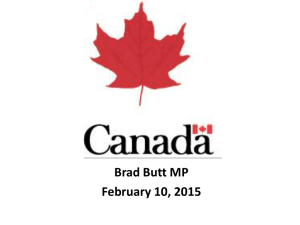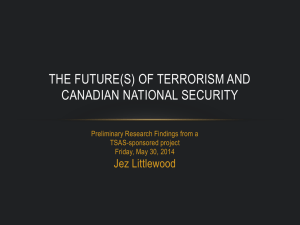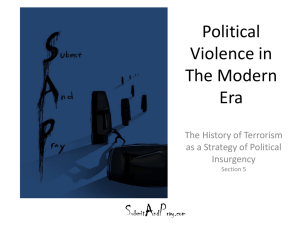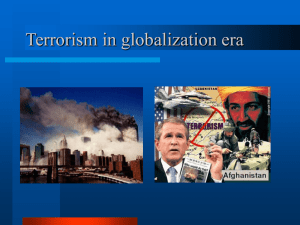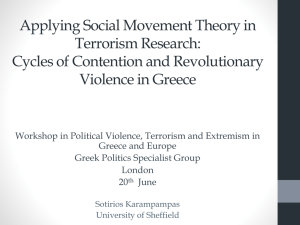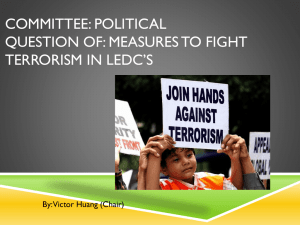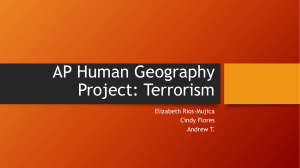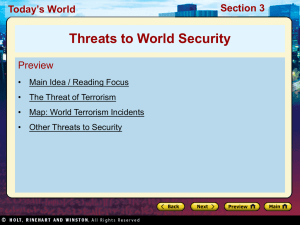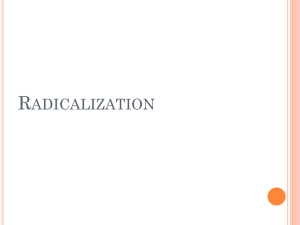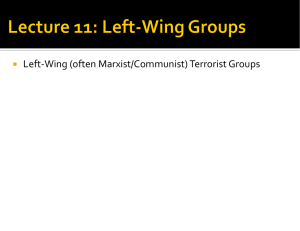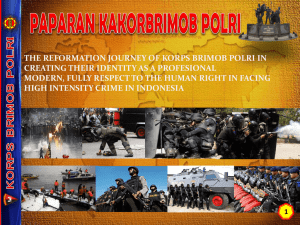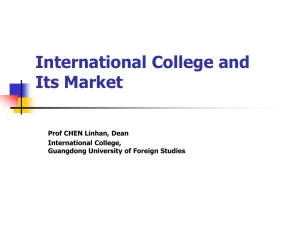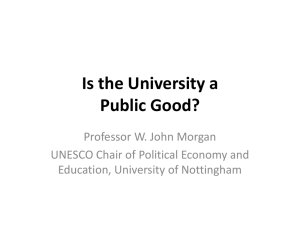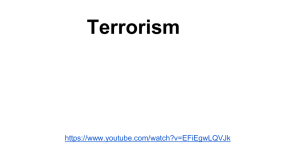Dissent and the Constitution
advertisement
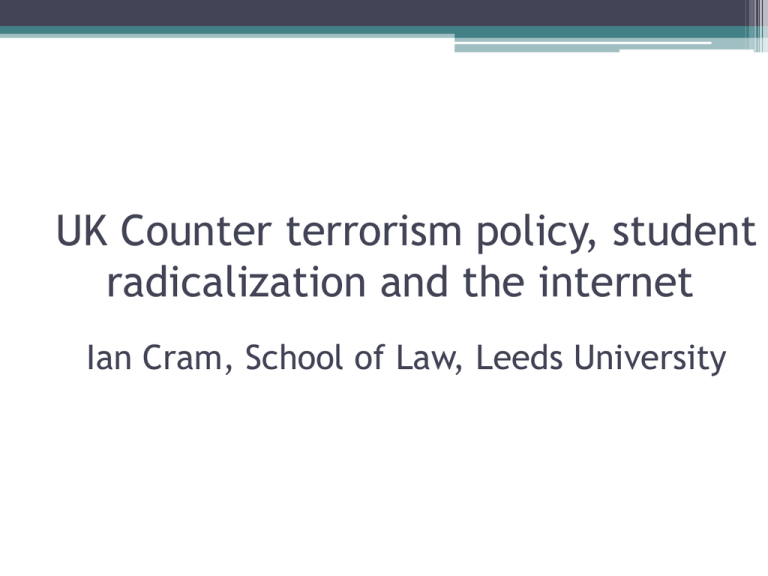
UK Counter terrorism policy, student radicalization and the internet Ian Cram, School of Law, Leeds University Pressure from the top to ‘deradicalise’universities • ‘...we have not done enough to deal with the promotion of extremist Islamism in our own country. Whether it is making sure that imams coming over to this country can speak English properly, or whether it is making sure that we deradicalise our universities, we have to take a range of further steps, and I am going to be working hard to make sure that we do.’ • PM Cameron, HC Debs (2010-11) Vol.520, col.910 (15/12/10) Pressure from Independent Reviewer of Counter Terrorism Law • Universities have ‘been slow or even reluctant to recognise their full responsibilities in the face of ‘unambiguous evidence of radicalising activities.’ Lord Carlile of Berriew, Independent Reviewer of Counter terrorism law and policy Broader Research Questions • How has the ‘war on terror’ impacted on freedom of expression and association in the UK? • To what extent might recent developments be problematic for a liberal democracy committed to rule of law, limited government, individual autonomy and informed self-rule? – has UK adopted a ‘militant-democracy’ style defence of the liberal state? If so – should this be of concern? Discrete measures impacting upon expressive freedoms • Proscription of political associations • Criminalising possession of documents (useful to persons committing etc acts if terrorism) – ‘reasonable excuse’ academic curiosity? • Indirect encouragement of terrorism (including ‘glorification’) • Withholding information about terrorist acts • Official Secrets Act prosecutions; DA notices • Production orders against journalists • Random stop & search of photographers (but see now HO Circular 012/ 2009 & ECtHR in Gillan (2010) App. No. 4158/05) ‘Radicalisation’ • Broad meaning – ‘process of adopting a system of ideas that overtly challenges an established social and/or political order’ • Narrow meaning ‘process of adopting a system of ideas that overtly challenges an established social and/or political order and leads them to commit/attempt to commit terrorist acts.’ • (Caldicott UCL Inquiry, para 8) CONTEST - UK COUNTER TERRORISM STRATEGY • ‘Prevent’ strand (early version 2006) • (i) deterring those who facilitate terrorism and those who encourage others to become terrorists by making more hostile the environment in which the extremists and those radicalising others can operate • and • (ii) tackling disadvantage and supporting reform by addressing structural problems in the UK and overseas that may contribute to radicalisation, such as inequalities and discrimination Prevent Mark 2 – elements of the elaborated strategy • Preventing Violent Extremism: Winning Hearts and Minds (Dept for Communities & Local Government) £6m fund to support local programmes intended ‘to build civic leadership and strengthen the role of faith leaders and institutions’ • Support for self-regulation in mosques • Radical Middle Way roadshows with visiting Muslim scholars to UK who challenge jihadist ideology • Universities- guidance on extremism on campus Quilliam Briefing Paper – Radicalisation on a British University Campuses - a case study (Oct 2010) • Looked at Isoc, City University London in Sept 2009June 2010 period • Claimed to find four ‘radicalising agents’ which made students ‘vulnerable’ to Islamic radicalisation which in turn produced a ‘potential’ for ‘radicalisation to Islamic terrorism’ Quilliam Briefing Paper – (contd) ‘Four radicalising agents’ • 1. Exposure to ideology that seems to sanction, legitimise or require violence • 2. Exposure to persuasive people or groups • 3. A crisis of identity • 4. A range of perceived grievances some real, some imagined to which there may seem no credible and effective non-violent response Some problematic aspects of counter-radicalisation strategy • Absence of unequivocal empirical evidence causally linking a specific terrorist act to exposure to ideology/persons at university. • Restrictive attitude of some groups (eg Quilliam, NUS) towards notion of free speech in general and academic freedom in particular • Existing, excessive restriction of radical speech via broadly drafted Terrorism & Public Order Laws – liberty of expression becomes a weak background assumption – weakness of HRA Academic freedom • Universities are ‘open institutions where ... debate, challenge and dissent are not only permitted but expected, and where controversial and offensive ideas are likely to be advanced. Intellectual freedom is fundamental to their mission, their teaching and their research.’ • Foreword UUK Freedom of Speech on campus – rights and responsibilities in UK Universities (Feb 2011) Council for Academic Freedom and Democracy (1972) • Whatever else they may be designed to do, academic institutions of all kinds and at all levels must be critical. They must be committed to reexamining accepted knowledge, assumptions and practices. It is their job, whatever other jobs they have, to nurse scepticism and to apply it to established beliefs and the present order. • The Case for Academic Freedom p.4 DIUS/BIS Scenarios – Example 3 ‘Inappropriate Student Use Of The Internet • College library staff have reported that a student has approached them expressing concerns at images she had seen fellow students looking at on computers in an IT room. She reported that two males were looking at some kind of home-made images of other men dressed in military and civilian clothing holding guns. The two men were joined by two others and she could see that they were watching shots being fired and explosions on the computer. The images then appeared to show somebody making a homemade explosive device.’ p.15 Universities’ qualified duty to uphold freedom of speech Education (No 2) Act 1986, s.43 Duty to ensure, so far as is reasonably practicable that the use of university premises is not denied to an individual or group on account of the views of that person/group. R v University of Liverpool ex parte Caesar-Gordon [1991] 1 QB 124 • Held – where threat of disorder or breach of peace on campus is made out, s.43 does not prevent university cancelling the meeting Revised definition of ‘terrorism’ • the use or threat of ‘action’ (serious violence against person, serious damage to property, endangering a person’s life, creating a risk to the health or safety of the public or a section of it, seriously interfering with/disrupting an electronic system) designed to influence the government, international government organisations or to intimidate the public or a section of it for the purpose of advancing a political, religious or ideological cause Terrorism Act 2000 s.1(4) “action” “person” “property” “government” apply to actions, persons, property and governments ANYWHERE IN THE WORLD (including anti-democratic, tyrannical regimes) Indirect encouragement of terrorism – Terrorism Act 2006 s.1 • (3) ... Include(s) every statement which— • (a) glorifies the commission or preparation (whether in the past, in the future or generally) of such acts or offences; and • (b) is a statement from which those members of the public could reasonably be expected to infer that what is being glorified is being glorified as conduct that should be emulated by them in existing circumstances. Breadth of glorification offence • ‘Glorifies’ includes any form of praise/celebration (s.20(2)) • Not necessary to show (i) that anyone was actually encouraged to commit an act of terrorism OR (ii) that the speech raised a real/serious threat of terrorist activity • No public interest defence • Could include praise of a past conflict Breadth of glorification offence • Expressing an understanding of reasons why persons engaged in resistance against a state (eg Israel, Zimbabwe, Chechnya, Libya, Yemen) COULD be construed as meeting the requirements of s.1, Terrorism Act 2006. • Even showing ‘positive’ side of combatants in a historical conflict (George Orwell’s depiction of an Italian Anarchist in Homage to Catalonia) could be problematic if capable of being understood as approving others to emulate today) • Defence if accused has no intent to encourage terrorism (directly/indirectly) AND (i) he/she did not endorse statement and (ii) non-endorsement was clear from all the circumstances Impact of terrorism laws in the academic context • May 2008 - Nottingham University - Arrests of Sabir (MA student) and Yezza (PA to Head of Mod Languages & Cultures) after latter downloaded an edited version of Al Qaeda training manual at Sabir’s asking (freely available on web via inter alia US Justice Dept) • Yezza’s colleagues noticed document on his computer when Yezza away from his desk and alerted police. • Both men arrested & released without charge after a few days • Nottingham VC - no right to access terrorist materials; those that do for research are likely to have a good defence after perhaps spending time in police detention (THES (2008) July 17, p.8) & see Barendt, Academic Freedom and the Law (2010) at p.258 UUK Freedom of Speech on campus – rights and responsibilities in UK Universities • Survey in 2010 revealed ‘extensive and generally productive engagement that exists between universities, their students and external organisations to allow debate and discussion on campus whilst at the same time being aware of the boundaries to this debate and the need for vigilance in safeguarding their student staff and wider community.’ (2011, p.31) UUK Freedom of Speech on campus – rights and responsibilities in UK Universities • Recommendations • Ensure that university personnel are familiar with legal requirements • Provide clear info to SUs and student societies about rights and responsibilities • Maintain dialogue with police, community groups, LAs • UUK to work with universities to develop policies and implementation strategies Quilliam’s risk avoidance stance • “(J)ust as it is right to be concerned about the danger of fascist rhetoric spilling over into violence, so it is right to be aware that extreme forms of Islam may provide a launch-pad for Islamic-inspired terrorism.” • Radicalisation on British University Campuses: a case study (2010) p.3.
